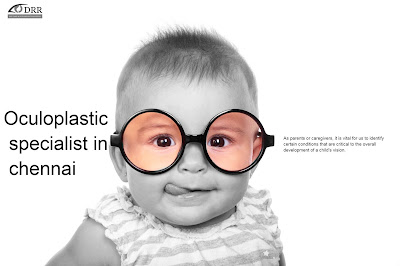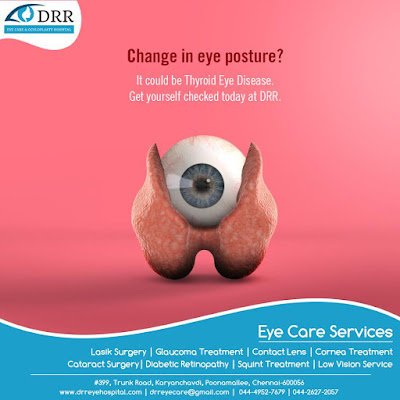 |
| Oculoplastic specialist in chennai |
As parents or caregivers, it is vital for us to identify certain conditions that are critical to the overall development of a child’s vision. Sometimes just a pair of glasses can fix a squinting eye whereas at other times more attention may be required.
PTOSIS: Ptosis is drooping of upper eyelid making the involved eye appear smaller. In severe ptosis, the child must tilt his head back, or raise the eyebrows, in order to see well. It can be present since birth or appear later in childhood. In some, it may be associated with more serious issues like heart disorder. Children with ptosis may have low self-esteem, especially because they are teased in school by other children. If the ptosis is severe, the visual development may be affected as the droopy eyelid covers the eye and the eye becomes a "lazy eye". This vision loss can be irreversible if left untreated. Hence these children require correction at an early age to avoid permanent defect in vision.
Lacrimal Disorders (Watering of the eye) – In children less than 1 year of age, watering of eyes is common, as the tear drainage pathway may be underdeveloped. There can be several serious disorders like glaucoma, foreign body or infection that can cause watery eyes. We recommend that you see an oculoplasty surgeon if the child has watering. If the watering is due to a block in the drainage tube, it can be corrected by simple massaging minimally invasive procedure at an early age. These when left untreated can lead to severe infection and sometimes even loss of vision.
Tumors – Tumors are common within the eye and also in the structures around the eye. Intraocular tumors should be suspected when there is a yellow reflex in the eye on a photograph with a flash, or unexplained squint, or unexplained bleeding within the eye. Congenital tumors are curable when diagnosed at an early age.
Entropion -Inward turning of the eyelid margin can cause the eyelashes to rub on the eye and damage the surface.
Eyelid defects: Some children are born with a defect or gap in the eyelid. As the normal eyelid protects the eyeball; a defect in the eyelid may expose the eye to dryness and infection which in turn can lead to visual deprivation.
Congenital absence of one or both eye: Children may be born with absence of one eye or abnormally small and dysfunctional eye. This can be psychologically very traumatizing for the parents. When left alone, the facial growth on the affected side may be hampered. The available empty socket can be expanded, and implants can be placed to help stimulate facial growth and give a socially acceptable cosmesis. A prosthetic /artificial eye can look very natural, and movement is possible in most cases. Artificial eyes can be placed after removal of a painful/cosmetically unacceptable, blind eye too.
Fracture: Sometimes fracture in the bone around the eye can occur following injury.
The child may not tell his parents about the trauma. However, if the child's eyeball is not moving normally in all directions or if the child has vomiting or double vision or squinting, he may be having a fracture. Remember the eye may look white and normal even with a fracture.
It is your duty to identify and rectify vision problems in your children. Most of the conditions are treated by simple procedures. But early detection and expert help is the key.
Note:
This Content Originally Published By DRR EYE HOSPITAL IN CHENNAI.http://www.drreyehospital.com/blogs/1



